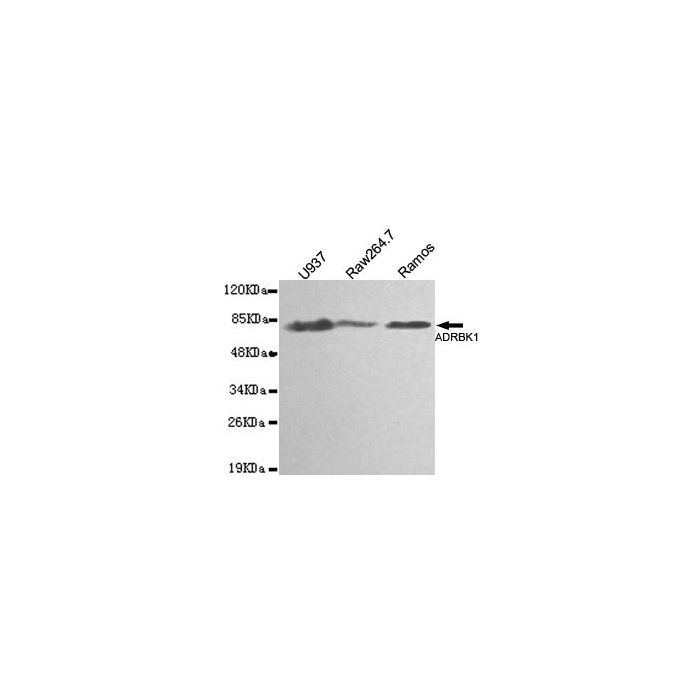GRK 2 / ADRBK1 (clone ), anti-human, mouse
€388.00
In stock
SKU
MB0139
Background:
Heterotrimeric G protein-mediated signal transduction is a dynamically regulated process with the intensity of signal decreasing over time despite the continued presence of the agonist. This phenomenon, referred to as agonistmediated desensitization, involves phosphorylation of the receptor by two classes of enzymes. The first are the second messenger-regulated kinases such as c-AMP dependent protein kinase A and protein kinase C. The second are the G protein-coupled receptor kinases (GRKs). At least seven members of the GRK family have been identified. These include rhodopsin kinase, GRK 1; two forms of β-adrenergic receptor kinase, GRK 2 (βARK, βARK1) and GRK 3 (βARK2); IT-11 (GRK 4); GRK 5, GRK 6 and GRK 7. Phosphorylation of receptors by GRKs appears to be strictly dependent on the receptor being in its agonist-activated state.
Alternative Name:
Beta-adrenergic receptor kinase 1, Beta-ARK-1, β-ARK-1, ARK-β1, G-protein coupled receptor kinase 2, ADRBK1, BARK, BARK1, GRK2, ARK β1, ARKβ1, β-ARK1
Application Dilution: WB: 1:1000
Specificity: This antibody detects endogenous levels of ADRBK1 and does not cross-react with related proteins
Immunogen:
Recombinant full length Human GRK 2 / ADRBK1.
MW: Predicted band size: 80KDa, Observed band size: 80KDa
Swis Prot.: P25098
Purification & Purity:
The antibody was affinity-purified from mouse ascites by affinity-chromatography using epitope-specific immunogen and the purity is > 95% (by SDS-PAGE).
Format:
Purified mouse monoclonal in buffer containing 0.1M Tris-Glycine (pH 7.4, 150 mM NaCl) with 0.2% sodium azide, 50%,glycerol
Storage:
Store at 4°C short term. Aliquot and store at -20°C long term. Avoid freeze-thaw cycles.
For research use only, not for use in diagnostic procedure.
Heterotrimeric G protein-mediated signal transduction is a dynamically regulated process with the intensity of signal decreasing over time despite the continued presence of the agonist. This phenomenon, referred to as agonistmediated desensitization, involves phosphorylation of the receptor by two classes of enzymes. The first are the second messenger-regulated kinases such as c-AMP dependent protein kinase A and protein kinase C. The second are the G protein-coupled receptor kinases (GRKs). At least seven members of the GRK family have been identified. These include rhodopsin kinase, GRK 1; two forms of β-adrenergic receptor kinase, GRK 2 (βARK, βARK1) and GRK 3 (βARK2); IT-11 (GRK 4); GRK 5, GRK 6 and GRK 7. Phosphorylation of receptors by GRKs appears to be strictly dependent on the receptor being in its agonist-activated state.
Alternative Name:
Beta-adrenergic receptor kinase 1, Beta-ARK-1, β-ARK-1, ARK-β1, G-protein coupled receptor kinase 2, ADRBK1, BARK, BARK1, GRK2, ARK β1, ARKβ1, β-ARK1
Application Dilution: WB: 1:1000
Specificity: This antibody detects endogenous levels of ADRBK1 and does not cross-react with related proteins
Immunogen:
Recombinant full length Human GRK 2 / ADRBK1.
MW: Predicted band size: 80KDa, Observed band size: 80KDa
Swis Prot.: P25098
Purification & Purity:
The antibody was affinity-purified from mouse ascites by affinity-chromatography using epitope-specific immunogen and the purity is > 95% (by SDS-PAGE).
Format:
Purified mouse monoclonal in buffer containing 0.1M Tris-Glycine (pH 7.4, 150 mM NaCl) with 0.2% sodium azide, 50%,glycerol
Storage:
Store at 4°C short term. Aliquot and store at -20°C long term. Avoid freeze-thaw cycles.
For research use only, not for use in diagnostic procedure.
| Is Featured? | No |
|---|
Write Your Own Review

